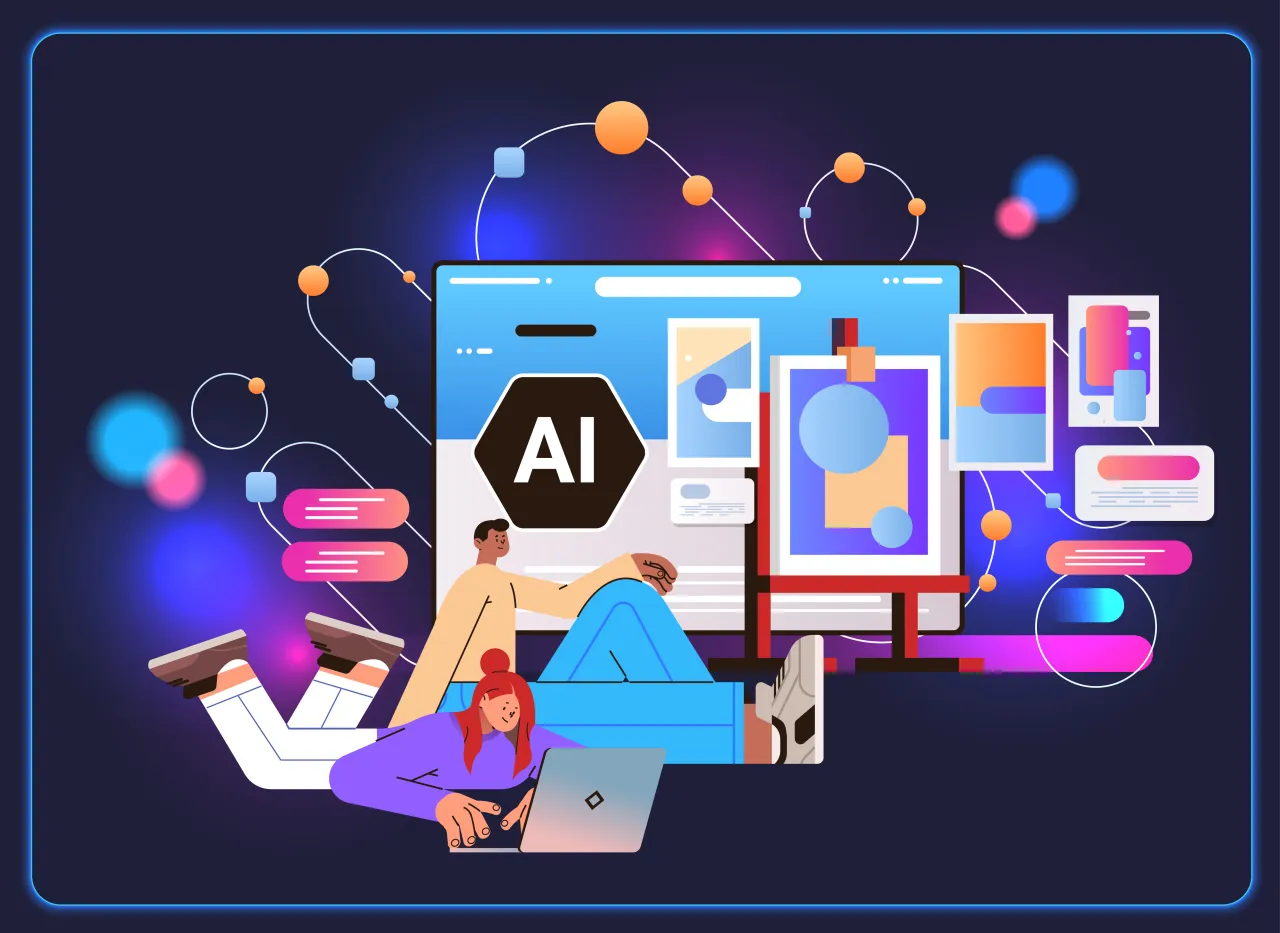What Is AI Analytics and How Does It Fuel Smarter Business Decisions? (With Examples)
AI is evolving so rapidly that it’s challenging to keep up with the know-how. No worries, though, we’ve got you covered. Today, let’s figure out how to use AI in data analytics, the main differences of AI analysis from traditional data science, its key benefits, and examples of use.
If you’re searching for ways to supercharge your visual content production, our commercially safe AI Image Generator is your go-to tool. Designed with businesses in mind, it’s perfect for brands and creators looking to transform their creative process with the help of licensed AI content.
What is AI analytics?
AI analytics is like data analysis on steroids. It’s the blend of artificial intelligence with the traditional human analysis we’ve relied on for years—but way smarter, faster, and more intuitive.
AI doesn’t just follow predefined rules. It learns continuously. The more data it processes, the smarter it gets. It refines predictions, uncovers trends sooner, and works up personalized recommendations. Imagine the level of insight a business can achieve with a tool that’s getting sharper by the second.
Let’s break down what AI analytics consists of:
- Machine Learning (ML) — the brain of AI analytics, where algorithms learn from the data without being told exactly what to do.
- Natural Language Processing (NLP) — the part that allows AI to understand and respond to human language, whether that’s emails, social media posts, or chat messages.
- Predictive analytics — this is where AI flexes its muscles, using deep learning and predicting what’s going to happen next based on all the data it’s been consuming.
Why is AI analytics important?
Our world is data-flooded, and the ability to process, learn from, and act on data autonomously is a pretty big deal. AI already empowers many businesses to make more data-driven decisions than ever before. So, if AI isn’t a breakthrough technology that can eventually impact all existing industries, what is?
First, AI is a cost-effective solution that helps with mastering big data that businesses are swimming in. Second, it drives tailored experiences, whatever data you’re working with—from customer interactions to operational metrics. This is particularly useful for domains such as retail and digital marketing. Last but not least, it brings sharper accuracy into your processes, as there’s less probability of an error, which is crucial for industries like healthcare or finance, where precision is everything.
Key differences between AI analytics and traditional data analysis
The main difference between AI analytics and traditional analytics lies in the approach to data processing and insight generation.
Think of traditional analytics as the trusty old bike you’ve been riding since childhood. It gets you from point A to B but has limitations—it’s rule-based, time-consuming, relies on data analysts’ intellectual capabilities, and is great at solving problems when you already know what you’re looking for. But when we throw in more complex terrain, it starts to struggle.
That’s where AI analytics comes in. Like upgrading to a high-performance electric bike, it brings in a completely different experience—capable of handling much tougher roads (or, in this case, data). AI supercharges human analysis by introducing machine learning and other advanced techniques into the mix. Here’s how:
Blazing-fast data processing
Traditional methods often require a lot of manual effort and can sometimes feel like a burden when dealing with massive, unstructured datasets—think predefined queries and lots of hand-holding. AI, on the other hand, runs the show by itself. It flashes through vast amounts of data at breakneck speed, which means more efficiency and less time spent tinkering with data.
“Job-Stealer” or “Co-Creator”? 5 Ways to Improve Design Quality with AI Safely
Always learning and adapting
Traditional analytics can only go so deep—it relies on static models and pre-programmed rules and is limited in its ability to uncover hidden gems buried in complex data. AI analytics is constantly evolving and adapting to the latest trends with every new piece of information. Like an X-ray, it’s very efficient when it comes to revealing patterns and insights that would otherwise go unnoticed.
Predictive and prescriptive analysis
Traditional analytics focuses on the past, explaining what happened and why. Sometimes, it can’t even explain why, but rather suggest potential scenarios that could lead to the result. What function does AI serve in predictive analytics? Well, it certainly takes it a step further, as AI is able to predict what’s coming next and offer useful recommendations on what to do about it.

Examples and benefits of using AI analytics
Marketing – customer analysis
AI is often applied in marketing to understand what customers really think, since intelligent tools can analyze social media posts, reviews, and other user-generated content to gauge public opinion about brands and products. This means marketers can get a pulse on customer preferences, track how campaigns are performing, and tweak strategies based on what people are saying—right as they’re saying it.
Tools like Sprinklr and Brandwatch use various AI models to analyze social media content, simplify data visualization, improve customer experience, drive productivity, and facilitate decision-making for those who deal with marketing and customer service.
AI Marketing: How to Enhance User Experience Through Automation
Retail – personalized experiences
By analyzing consumer behavior, purchase history, and real-time browsing activity, AI helps brands serve up tailored recommendations that boost sales and keep customers coming back for more. And it’s not just about getting the right product in front of the right person at the right time. AI-driven insights help retailers optimize everything from pricing strategies to inventory management, making sure their shelves (virtual or physical) are always stocked with what’s in demand.
Take Amazon, for example. The e-commerce giant uses AI to enhance the customer experience from browsing to unboxing. AI allows them to recommend products to users based on their past searches, purchases, and even the behavior of other shoppers with similar tastes. Shoppers can also tweak product listings and create killer ads with the help of AI. Next, Amazon streamlines their packaging process like monitoring produce and identifying damaged items. It’s smart shopping, indeed.
Learn How to Improve a Client’s Shopping Experience with Image AI
Financial services – fraud detection
In finance, AI analytics is like having a digital detective working around the clock to sniff out fraud. By analyzing transaction patterns in real time, AI systems can spot suspicious behaviors faster than any human. And it’s more than catching the obvious stuff—AI can detect those subtle, sneaky patterns that traditional methods might miss, making fraud prevention more accurate. As a result, AI-powered financial systems minimize costs, enhance security, and build consumer trust by nipping fraudulent activities in the bud.
For example, Mastercard uses AI to track transaction anomalies and detect potentially compromised cards, keeping their operations smooth and their customers protected.
Healthcare – predictive diagnosis
In healthcare, AI analytics is literally proving to be a real lifesaver. It’s being used to predict patient outcomes and diagnose diseases with remarkable accuracy. But the benefits don’t stop there. AI-powered diagnostics can help reduce human error, detect diseases earlier, and create personalized treatment plans tailored to each patient’s unique needs. For hospitals and clinics, AI is streamlining operations, cutting down on wait times, and elevating the overall quality of care.
Systems like IBM Watson use AI for healthcare to look into patient data, medical records, and the latest research, giving doctors the insights they need to make smarter decisions about diagnosis and treatment.
Manufacturing – improved operations and maintenance
When it comes to manufacturing, downtime means money down the drain, so high business intelligence is crucial to keep things running smoothly. That’s where AI analytics steps in, predicting equipment failures before they even happen. By analyzing sensor data and operational metrics, AI can anticipate when machines are about to break down and recommend just-in-time maintenance schedules to prevent interruptions. This approach—known as predictive maintenance—extends the lifespan of the industrial equipment, cuts repair costs, and keeps production on track.
For example, General Electric Vernova created their own AI-based software to improve industrial sustainability and optimize operations:
“For a sustainability solution to be effective for industry, it must converge sustainability with operational excellence and digitization, ensuring that not only are energy consumption and raw material resources being optimized, but that plants maximize productivity, performance KPIs, and ultimately profitability.”
—Craig Resnick, Vice President, ARC Advisory Group
What’s next in the world of AI?
As AI evolves, expect analytics to become even more automated, with businesses relying on AI to make decisions without much human input. Hyper-personalization will ramp up too as companies precisely tailor products, services, and communications to individual customers.
AI-powered business models will become the norm, with AI analytics driving key operations. We’ll also likely see AI integrated with other emerging tech like blockchain, Internet of Things (IoT), and augmented reality.
But as AI spreads, ethical concerns around data privacy, bias, and transparency will push new regulations. Companies will need to stay compliant and transparent. And AI tools won’t just be for the big players—small and medium-sized businesses will get in on the action as costs drop and platforms become more accessible.
Boost your visual content game with our commercially safe AI Image Generator and best AI Art Generator out there. Built for businesses and individual creators, it’s here to transform your design process with the power of licensed AI-generated images.
Read more about tech and artificial intelligence
7 Common Misconceptions about AI-generated Images
Amazing Images Generated with Depositphotos AI: Collection & Tips to Craft Your Own
7 Examples of How Product Companies Embrace Generative AI to Boost Value Proposition












